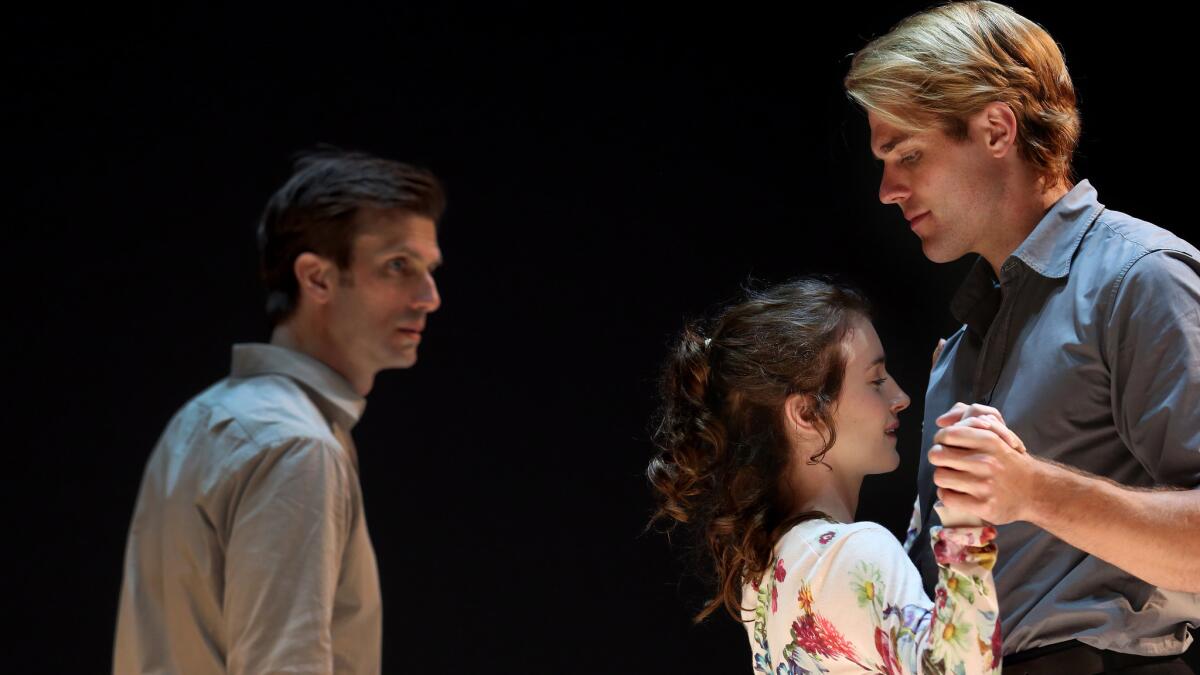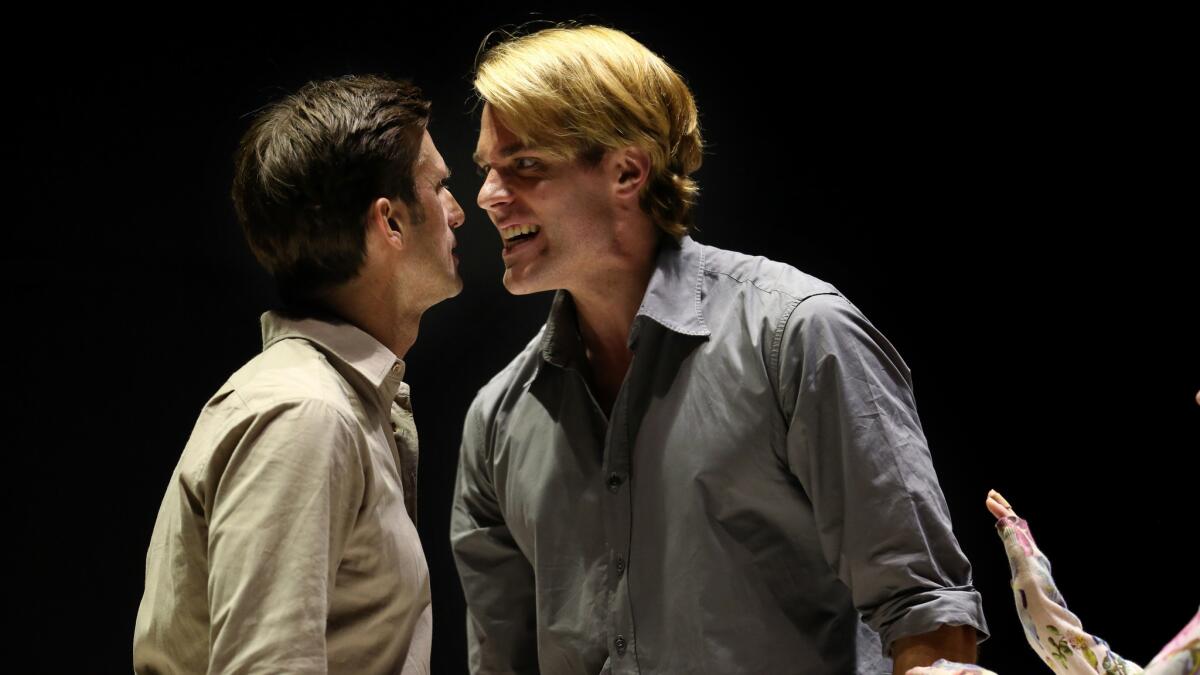Review: A smoldering âView From the Bridgeâ turns up the heat at the Ahmanson

In Ivo van Hoveâs celebrated production of Arthur Millerâs âA View From the Bridge,â the direction is the star. The Belgian auteur, who leads Hollandâs preeminent theater company, Toneelgroep Amsterdam, made his Broadway debut with this stylized revival that took London by storm.
Itâs not a common occurrence that a deconstructed production of a contemporary classic winds up winning both the Olivier Award and the Tony Award for best direction. But this turned out to be a stunningly fruitful match of sensibilities.
Van Hove is an avant-gardist with a keen appreciation for plays â American plays in particular. His off-Broadway productions of work by Tennessee Williams and Eugene OâNeill earned him a cult following in the U.S. that has only expanded as audiences have grown more appreciative of his stark X-ray tactics exposing the psychosexual subtexts of drama we mistakenly assumed we already knew.
If ever there were a play that could use van Hoveâs interpretive seduction, itâs Millerâs smoldering domestic drama, set near the loading docks in Brooklynâs Red Hook in the 1950s. The story centers on Eddie Carbone, a longshoreman whose unacknowledged passion for his 17-year-old niece creates havoc at home when the young woman falls in love with one of his wifeâs cousins from Italy who have entered the country illegally to find work.
Eddie (Frederick Weller) and his wife, Beatrice (Andrus Nichols), have raised Catherine (Catherine Combs), who has just been offered a job while still in secretary school. Eddie is fiercely overprotective and doesnât like the idea of her leaving the nest. He says he made a vow to Catherineâs mother, but his behavior rings Freudian alarm bells.
He jealously disapproves of Catherine clacking around the streets in heels and complains that her new skirt is too short. The connection they have is conspicuously more affectionate than the one he has with his wife, who turns a blind eye to her husbandâs obsessive interest in the girl. This is her sisterâs daughter, after all. Eddie has been sacrificing for her blood. And soon, she hopes, Catherine will start work, find a husband and begin her own life in blue-collar Brooklyn.
When Marco (Alex Esola) and Rodolpho (Dave Register) step off the boat and into Eddieâs tenement apartment, the pressure that has been building in the household only intensifies. Marco, who has come to America to send money to his wife and three hungry kids, is hardworking and respectful. But Eddie has a problem with Rodolpho, whose blond hair and bubbly demeanor have captured Catherineâs attention.

Eddie raises suspicions about Rodolphoâs character and masculinity, planting the doubt that heâs just after Catherine for his citizenship. When he consults with Alfieri (Thomas Jay Ryan), a lawyer who serves as neighborhood sage and the playâs narrator and chorus, about what to do with the freeloading visitor whoâs disrespecting his authority, it becomes clear to everyone but Eddie that his own motives have more to do with lust than with law and order.
Most productions treat the sexual heat between Eddie and Catherine as a subterranean disturbance. Van Hove, however, brings the desire to the surface and makes it a family affair. When Eddie comes home after a long dayâs work, Catherine leaps into his arms and wraps her legs around him.
Such flamboyant gymnastics may seem like a distortion of Millerâs text, but van Hoveâs choices emerge from a careful study of the play. The staging literalizes Beatriceâs complaint to Catherine about her inappropriate behavior: âLike when he comes home sometimes you throw yourself at him like when you was 12 years old.â
We may not see Catherine sitting on the edge of the tub while her uncle is shaving in his underwear â another of Beatriceâs gripes â but the sexuality between them is unmistakable. Wellerâs Eddie canât be within reaching distance of Combsâ Catherine without rubbing her legs or fondling her wrists. This touching operates under the cover of family love.
If van Hoveâs direction transforms the audience into voyeurs at times, the scenic design by van Hoveâs close collaborator Jan Versweyveld turns theatergoers into a combination of spectators at a boxing match and jurors at a trial.
A portion of the audience is seated on the stage on opposite sides of the gray rectangular set. A glass perimeter adds to the fishbowl quality of the production. The whole town is indeed watching.
SIGN UP for the free Essential Arts & Culture newsletter Âť
There is one darkened door from which characters emerge and depart as though in a dreamscape. The actors move about this space with the formal fluidity of a chess game. Again, van Hove takes his staging cues from Miller. After warning Eddie that he has no legal leg to stand on in preventing Catherine from marrying Rodolpho, Alfieri shares with the audience his sense of the taleâs tragic foreboding: âI could see every step coming, step after step, like a dark figure walking down a hall toward a certain door.â
Millerâs ambition to turn this material into tragedy isnât successfully realized. âA View From the Bridgeâ is a famous play, but it isnât a great one. Alfieriâs closing speech, even spoken by an actor as distinctively commanding as Ryan, reveals an author nervously trying to compensate for his playâs shortcomings.
Iâm not alone in this assessment. Film critic Pauline Kael, in a hilarious pan of the 1962 movie, noted, âWhat looks like and, for some people, passes for tragic inevitability is just poor playwriting.â The formidable drama critic Richard Gilman said of a 1983 revival that the play, âa muddled and textbookish tale of sexual desire, is in no way âlarger-than-life,â and the effort to make it so is precisely what makes it so melodramatic.â
But hereâs where van Hoveâs art proves so redemptive: His production magnifies the conflicts that are festering under the dramatic surface, imbuing banal exchanges with Pinteresque shadows and slowing the dialogue when tempers are most apt to explode. Even at its most wildly exaggerated, the staging focuses our attention on Millerâs writing at its ambiguous best.
The preternatural stillness of the actors allows their sudden extravagant movements to take on heightened significance. The sound design by Tom Gibbons â a droning angst one moment, a percussive tap threatening violent ruin the next â quickens the dramatic pulse. The final scene â though marred by a technical glitch at Wednesdayâs opening â makes the leap from experimental theater to 21st century opera.
Millerâs vision may not attain Sophoclean heights, but this production from Londonâs Young Vic is enthralling even when the play falters. In sum, it was a pleasure to see van Hoveâs aesthetic on the Ahmanson stage. I had fears that the theater would be too cavernous, but from where I was sitting the production established the necessary intimacy.
In New York, âA Viewâ was anchored by the performance of Mark Strong, who sensationally reprised his award-winning London portrayal of Eddie. Weller doesnât dominate the stage as Strong did, but he brings his own forceful drive to the role.
Combsâ Catherine makes a wonderfully innocent Italian American Lolita. Nicholsâ Beatrice is perhaps the most authentically naturalistic performance in a production that isnât aiming for kitchen-sink realism. Neither Esolaâs Marco nor Registerâs Rodolpho speaks with the faintest trace of an Italian accent, but the theatrical truth of their characters is vividly on display.
An DâHuysâ costumes extend the modern adaptation of period style. The world van Hove constructs cannot be precisely located and yet has a sexy consistency all its own. Whatever you think about the merits of Millerâs demi-classic, this is a magnificently concentrated revival of âA View From the Bridge.â
------------
âA View From the Bridgeâ
Where: Ahmanson Theatre, 135 N. Grand Ave., L.A.
When: 8 p.m. Tuesdays-Fridays, 2 and 8 p.m. Saturdays, 1 and 6:30 p.m. Sundays. Ends Oct. 16. Call for exceptions.
Tickets: $25-$125 (subject to change)
Information: (213) 972-4400 or www.centertheatregroup.org
Running time: 2 hours with no intermission
Follow me @charlesmcnulty
ALSO
Feature: Ivo van Hove brings his stripped-down âView From the Bridgeâ to Los Angeles
Review: Resilience and dignity are the rich, bluesy music of âMa Raineyâs Black Bottomâ
Feature: From âBeasts of the Southern Wildâ to âBurnpile,â Lucy Alibar finds her voice
More to Read
The biggest entertainment stories
Get our big stories about Hollywood, film, television, music, arts, culture and more right in your inbox as soon as they publish.
You may occasionally receive promotional content from the Los Angeles Times.











